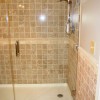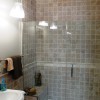Tub and Shower Doors
Tub and shower doors are fixed, operable enclosures that are used to access a residential tub or shower and keep the water in. Besides being functional, they are a decorative selection that takes the place of a traditional horizontal rod and curtain.
Similar to most products and materials, tub and shower door types each have their own advantages and disadvantages. Sliding and folding door tracks are designed and fabricated to allow water to drain back into the tub. If not properly maintained, water will not pass through and properly escape the track, causing an unattractive build up of soap and mildew which may negatively affect the operation of the doors. Sliding doors have a limited amount of opening (50%) through which the tub is accessible. This lack of accessibility presents a challenge when installed on a tub where an elderly or handicapped individual or children need assistance. Folding panels and pivoting screens, however, provide a larger opening.
The sliding, folding and pivoting screen doors offer the greatest structural stability and sturdiness. In addition, they offer greater splash protection because the panels overlap each other. Swing doors can lack stability at the door if improperly hung, because the hinging and/or pivoting mechanisms are weak points within the construction. Swinging doors do not have a bottom track, similar to other door types. They instead have rubber seals and sweeps that do an acceptable job of minimizing leakage.
Enclosures and doors can have metal framed or frameless glass. Glazing styles and metal trim are available in many colors and finishes. Tub and shower doors are considered to be "green" products because the materials used are recyclable, and often the systems themselves are manufactured with recycled materials.

Buildipedia Staff
The Buildipedia research and writing staff consists of dozens of experienced professionals from many sectors of the industry, including architects, designers, contractors, and engineers.
Website: buildipedia.com/

